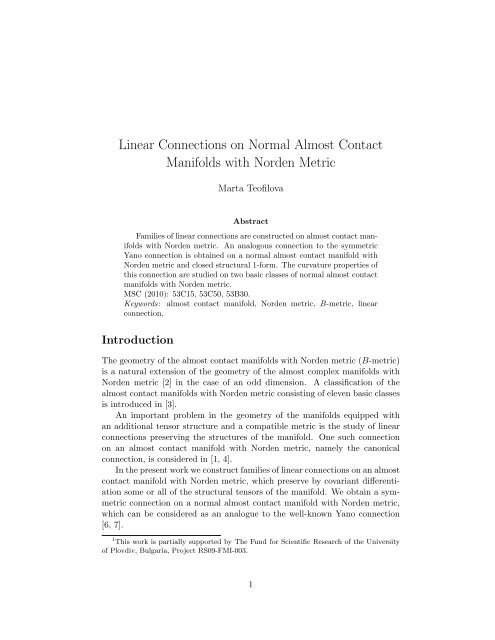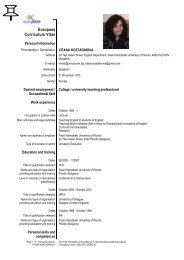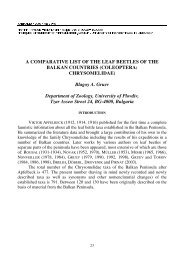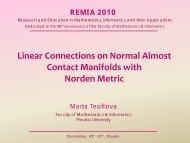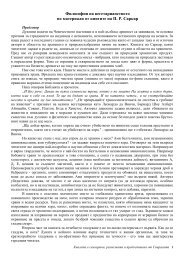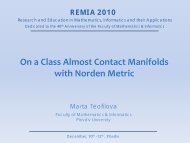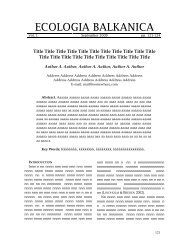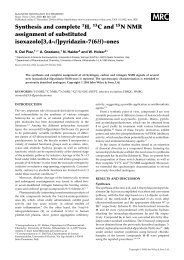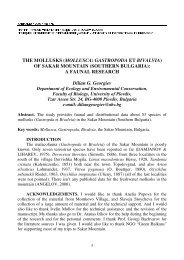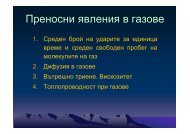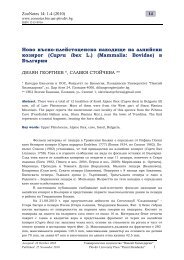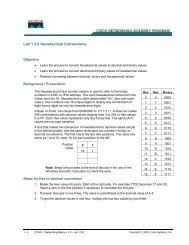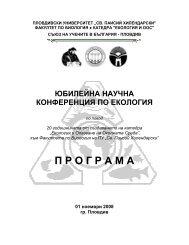Linear Connections on Normal Almost Contact Manifolds with ...
Linear Connections on Normal Almost Contact Manifolds with ...
Linear Connections on Normal Almost Contact Manifolds with ...
You also want an ePaper? Increase the reach of your titles
YUMPU automatically turns print PDFs into web optimized ePapers that Google loves.
<str<strong>on</strong>g>Linear</str<strong>on</strong>g> <str<strong>on</strong>g>C<strong>on</strong>necti<strong>on</strong>s</str<strong>on</strong>g> <strong>on</strong> <strong>Normal</strong> <strong>Almost</strong> C<strong>on</strong>tact<strong>Manifolds</strong> <strong>with</strong> Norden MetricMarta TeofilovaAbstractFamilies of linear c<strong>on</strong>necti<strong>on</strong>s are c<strong>on</strong>structed <strong>on</strong> almost c<strong>on</strong>tact manifolds<strong>with</strong> Norden metric. An analogous c<strong>on</strong>necti<strong>on</strong> to the symmetricYano c<strong>on</strong>necti<strong>on</strong> is obtained <strong>on</strong> a normal almost c<strong>on</strong>tact manifold <strong>with</strong>Norden metric and closed structural 1-form. The curvature properties ofthis c<strong>on</strong>necti<strong>on</strong> are studied <strong>on</strong> two basic classes of normal almost c<strong>on</strong>tactmanifolds <strong>with</strong> Norden metric.MSC (2010): 53C15, 53C50, 53B30.Keywords: almost c<strong>on</strong>tact manifold, Norden metric, B-metric, linearc<strong>on</strong>necti<strong>on</strong>.Introducti<strong>on</strong>The geometry of the almost c<strong>on</strong>tact manifolds <strong>with</strong> Norden metric (B-metric)is a natural extensi<strong>on</strong> of the geometry of the almost complex manifolds <strong>with</strong>Norden metric [2] in the case of an odd dimensi<strong>on</strong>. A classificati<strong>on</strong> of thealmost c<strong>on</strong>tact manifolds <strong>with</strong> Norden metric c<strong>on</strong>sisting of eleven basic classesis introduced in [3].An important problem in the geometry of the manifolds equipped <strong>with</strong>an additi<strong>on</strong>al tensor structure and a compatible metric is the study of linearc<strong>on</strong>necti<strong>on</strong>s preserving the structures of the manifold. One such c<strong>on</strong>necti<strong>on</strong><strong>on</strong> an almost c<strong>on</strong>tact manifold <strong>with</strong> Norden metric, namely the can<strong>on</strong>icalc<strong>on</strong>necti<strong>on</strong>, is c<strong>on</strong>sidered in [1, 4].In the present work we c<strong>on</strong>struct families of linear c<strong>on</strong>necti<strong>on</strong>s <strong>on</strong> an almostc<strong>on</strong>tact manifold <strong>with</strong> Norden metric, which preserve by covariant differentiati<strong>on</strong>some or all of the structural tensors of the manifold. We obtain a symmetricc<strong>on</strong>necti<strong>on</strong> <strong>on</strong> a normal almost c<strong>on</strong>tact manifold <strong>with</strong> Norden metric,which can be c<strong>on</strong>sidered as an analogue to the well-known Yano c<strong>on</strong>necti<strong>on</strong>[6, 7].1 This work is partially supported by The Fund for Scientific Research of the Universityof Plovdiv, Bulgaria, Project RS09-FMI-003.1
1 PreliminariesLet (M, ϕ, ξ, η, g) be a (2n+1)-dimensi<strong>on</strong>al almost c<strong>on</strong>tact manifold <strong>with</strong> Nordenmetric, i.e. (ϕ, ξ, η) is an almost c<strong>on</strong>tact structure: ϕ is an endomorphismof the tangent bundle of M, ξ is a vector field, η is its dual 1-form, and g is apseudo-Riemannian metric, called a Norden metric (or a B-metric), such that(1.1)ϕ 2 x = −x + η(x)ξ, η(ξ) = 1,g(ϕx, ϕy) = −g(x, y) + η(x)η(y)for all x, y ∈ X(M).From (1.1) it follows ϕξ = 0, η ◦ ϕ = 0, η(x) = g(x, ξ), g(ϕx, y) = g(x, ϕy).The associated metric ˜g of g is defined by ˜g(x, y) = g(x, ϕy)+η(x)η(y) andis a Norden metric, too. Both metrics are necessarily of signature (n + 1, n).Further, x, y, z, u will stand for arbitrary vector fields in X(M).Let ∇ be the Levi-Civita c<strong>on</strong>necti<strong>on</strong> of g. The fundamental tensor F isdefined by(1.2) F (x, y, z) = g ((∇ x ϕ)y, z)and has the following properties(1.3)F (x, y, z) = F (x, z, y),F (x, ϕy, ϕz) = F (x, y, z) − F (x, ξ, z)η(y) − F (x, y, ξ)η(z).Equalities (1.3) and ϕξ = 0 imply F (x, ξ, ξ) = 0.Let {e i , ξ}, (i = 1, 2, ..., 2n) be a basis of the tangent space T p M at anarbitrary point p of M, and g ij be the comp<strong>on</strong>ents of the inverse matrix of(g ij ) <strong>with</strong> respect to {e i , ξ}.The following 1-forms are associated <strong>with</strong> F :θ(x) = g ij F (e i , e j , x), θ ∗ (x) = g ij F (e i , ϕe j , x), ω(x) = F (ξ, ξ, x).A classificati<strong>on</strong> of the almost c<strong>on</strong>tact manifolds <strong>with</strong> Norden metric isintroduced in [3]. Eleven basic classes F i (i = 1, 2, ..., 11) are characterizedthere according to the properties of F .The Nijenhuis tensor N of the almost c<strong>on</strong>tact structure (ϕ, ξ, η) is definedin [5] by N(x, y) = [ϕ, ϕ](x, y) + dη(x, y)ξ, i.e. N(x, y) = ϕ 2 [x, y] + [ϕx, ϕy] −ϕ[ϕx, y] − ϕ[x, ϕy] + (∇ x η)y.ξ − (∇ y η)x.ξ. The almost c<strong>on</strong>tact structure insaid to be integrable if N = 0. In this case the almost c<strong>on</strong>tact manifold iscalled normal [5].In terms of the covariant derivatives of ϕ and η the tensor N is expressed byN(x, y) = (∇ ϕx ϕ)y − (∇ ϕy ϕ)x − ϕ(∇ x ϕ)y + ϕ(∇ y ϕ)x + (∇ x η)y.ξ − (∇ y η)x.ξ,2
where (∇ x η)y = F (x, ϕy, ξ). Then, according to (1.2), the corresp<strong>on</strong>dingtensor of type (0,3), defined by N(x, y, z) = g(N(x, y), z), has the form(1.4)N(x, y, z) = F (ϕx, y, z) − F (ϕy, x, z) − F (x, y, ϕz)+ F (y, x, ϕz) + F (x, ϕy, ξ)η(z) − F (y, ϕx, ξ)η(z).The c<strong>on</strong>diti<strong>on</strong> N = 0 and (1.4) imply(1.5) F (x, y, ξ) = F (y, x, ξ), ω = 0.The 1-form η is said to be closed if dη = 0, i.e. if (∇ x η)y = (∇ y η)x.The class of the almost c<strong>on</strong>tact manifolds <strong>with</strong> Norden metric satisfying thec<strong>on</strong>diti<strong>on</strong>s N = 0 and dη = 0 is F 1 ⊕ F 2 ⊕ F 4 ⊕ F 5 ⊕ F 6 [3].Analogously to [2], we define an associated tensor Ñ of N by(1.6)Ñ(x, y, z) = F (ϕx, y, z) + F (ϕy, x, z) − F (x, y, ϕz)− F (y, x, ϕz) + F (x, ϕy, ξ)η(z) + F (y, ϕx, ξ)η(z).From Ñ = 0 it follows F (ϕx, ϕy, ξ) = F (y, x, ξ), ω = 0. The class <strong>with</strong> Ñ = 0is F 3 ⊕ F 7 [3].The curvature tensor R of ∇ is defined as usually byR(x, y)z = ∇ x ∇ y z − ∇ y ∇ x z − ∇ [x,y] z,and its corresp<strong>on</strong>ding tensor of type (0,4) is given by R(x, y, z, u) = g(R(x, y)z, u).A tensor L of type (0,4) is said to be curvature-like if it has the propertiesof R, i.e. L(x, y, z, u) = −L(y, x, z, u) = −L(x, y, u, z) and Sx,y,zL(x, y, z, u) = 0(first Bianchi identity), where S is the cyclic sum by three arguments.A curvature-like tensor L is called a ϕ-Kähler-type tensor if L(x, y, ϕz, ϕu) =−L(x, y, z, u).2 <str<strong>on</strong>g>C<strong>on</strong>necti<strong>on</strong>s</str<strong>on</strong>g> <strong>on</strong> almost c<strong>on</strong>tact manifolds<strong>with</strong> Norden metricLet ∇ ′ be a linear c<strong>on</strong>necti<strong>on</strong> <strong>with</strong> deformati<strong>on</strong> tensor Q, i.e. ∇ ′ xy = ∇ x y +Q(x, y). If we denote Q(x, y, z) = g(Q(x, y), z), then(2.1) g(∇ ′ xy − ∇ x y, z) = Q(x, y, z).Definiti<strong>on</strong> 2.1. A linear c<strong>on</strong>necti<strong>on</strong> ∇ ′ <strong>on</strong> an almost c<strong>on</strong>tact manifold is calledan almost ϕ-c<strong>on</strong>necti<strong>on</strong> if ϕ is parallel <strong>with</strong> respect to ∇ ′ , i.e. if ∇ ′ ϕ = 0.3
Because of (1.2), equality (2.1) and ∇ ′ ϕ = 0 imply the c<strong>on</strong>diti<strong>on</strong> for Q(2.2) F (x, y, z) = Q(x, y, ϕz) − Q(x, ϕy, z).Theorem 2.1. On an almost c<strong>on</strong>tact manifold <strong>with</strong> Norden metric there existsa 10-parametric family of almost ϕ-c<strong>on</strong>necti<strong>on</strong>s ∇ ′ of the form (2.1) <strong>with</strong>deformati<strong>on</strong> tensor Q given by(2.3)Q(x, y, z) = 1 2{F (x, ϕy, z) + F (x, ϕy, ξ)η(z)} − F (x, ϕz, ξ)η(y)+t 1 {F (y, x, z) + F (ϕy, ϕx, z) − F (y, x, ξ)η(z) − F (ϕy, ϕx, ξ)η(z)−F (y, z, ξ)η(x) − F (ξ, x, z)η(y) + η(x)η(y)ω(z)}+t 2 {F (z, x, y) + F (ϕz, ϕx, y) − F (z, x, ξ)η(y) − F (ϕz, ϕx, ξ)η(y)−F (z, y, ξ)η(x) − F (ξ, x, y)η(z) + η(x)η(z)ω(y)}+t 3 {F (y, ϕx, z) − F (ϕy, x, z) − F (y, ϕx, ξ)η(z) + F (ϕy, x, ξ)η(z)−F (y, ϕz, ξ)η(x) − F (ξ, ϕx, z)η(y) + η(x)η(y)ω(ϕz)}+t 4 {F (z, ϕx, y) − F (ϕz, x, y) − F (z, ϕx, ξ)η(y) + F (ϕz, x, ξ)η(y)−F (z, ϕy, ξ)η(x) − F (ξ, ϕx, y)η(z) + η(x)η(z)ω(ϕy)}+t 5 {F (ϕy, z, ξ) + F (y, ϕz, ξ) − η(y)ω(ϕz)}η(x)+t 6 {F (ϕz, y, ξ) + F (z, ϕy, ξ) − ω(ϕy)η(z)}η(x)+t 7 {F (ϕy, ϕz, ξ) − F (y, z, ξ) + η(y)ω(z)}η(x)+t 8 {F (ϕz, ϕy, ξ) − F (z, y, ξ) + ω(y)η(z)}η(x)+t 9 ω(x)η(y)η(z) + t 10 ω(ϕx)η(y)η(z), t i ∈ R, i = 1, 2, ..., 10.Proof. The proof of the statement follows from (2.2), (2.3) and (1.3) by directverificati<strong>on</strong> that ∇ ′ ϕ = 0 for all t i .Let N = dη = 0. By (1.4), (1.5) from Theorem 2.1 we obtainCorollary 2.1. Let (M, ϕ, ξ, η, g) be a F 1 ⊕F 2 ⊕F 4 ⊕F 5 ⊕F 6 -manifold. Then,the deformati<strong>on</strong> tensor Q of the almost ϕ-c<strong>on</strong>necti<strong>on</strong>s ∇ ′ defined by (2.1) and(2.3) has the form(2.4)Q(x, y, z) = 1 2{F (x, ϕy, z) + F (x, ϕy, ξ)η(z)} − F (x, ϕz, ξ)η(y)+s 1 {F (y, x, z) + F (ϕy, ϕx, z)} + s 2 {F (y, ϕx, z) − F (ϕy, x, z)}+s 3 F (y, ϕz, ξ)η(x) + s 4 F (y, z, ξ)η(x),where s 1 = t 1 +t 2 , s 2 = t 3 +t 4 , s 3 = 2(t 5 +t 6 )−t 3 −t 4 , s 4 = −t 1 −t 2 −2(t 7 +t 8 ).4
Definiti<strong>on</strong> 2.2. A linear c<strong>on</strong>necti<strong>on</strong> ∇ ′ is said to be almost c<strong>on</strong>tact if thealmost c<strong>on</strong>tact structure (ϕ, ξ, η) is parallel <strong>with</strong> respect to it, i.e. if ∇ ′ ϕ =∇ ′ ξ = ∇ ′ η = 0.Then, in additi<strong>on</strong> to the c<strong>on</strong>diti<strong>on</strong> (2.2), for the deformati<strong>on</strong> tensor Q ofan almost c<strong>on</strong>tact c<strong>on</strong>necti<strong>on</strong> given by (2.1) we also have(2.5) F (x, ϕy, ξ) = Q(x, y, ξ) = −Q(x, ξ, y).Definiti<strong>on</strong> 2.3. A linear c<strong>on</strong>necti<strong>on</strong> <strong>on</strong> an almost c<strong>on</strong>tact manifold <strong>with</strong> Nordenmetric (M, ϕ, ξ, η, g) is said to be natural if ∇ ′ ϕ = ∇ ′ η = ∇ ′ g = 0.The c<strong>on</strong>diti<strong>on</strong> ∇ ′ g = 0 and (2.1) yield(2.6) Q(x, y, z) = −Q(x, z, y).From (1.6) and (2.3) we computeQ(x, y, z) + Q(x, z, y) == (t 1 + t 2 ){Ñ(y, z, ϕx) − Ñ(ξ, y, ϕx)η(z) − Ñ(ξ, z, ϕx)η(y)}(2.7)−(t 3 + t 4 ){Ñ(y, z, x) − Ñ(ξ, y, x)η(z) − Ñ(ξ, z, x)η(y)}−(t 5 + t 6 ){Ñ(ϕ2 z, y, ξ) + Ñ(z, ξ, ξ)η(y)}η(x)+(t 7 + t 8 ){Ñ(ϕz, y, ξ) − Ñ(ϕz, ξ, ξ)η(y)}η(x)+2{t 9 ω(x) + t 10 ω(ϕx)}η(y)η(z).By (2.1), (2.3), (2.5), (2.6) and (2.7) we prove the followingPropositi<strong>on</strong> 2.1. Let (M, ϕ, ξ, η, g) be an almost c<strong>on</strong>tact manifold <strong>with</strong> Nordenmetric, and let ∇ ′ be the 10-parametric family of almost ϕ-c<strong>on</strong>necti<strong>on</strong>sdefined by (2.1) and (2.3). Then(i) ∇ ′ are almost c<strong>on</strong>tact iff t 1 + t 2 − t 9 = t 3 + t 4 − t 10 = 0;(ii) ∇ ′ are natural iff t 1 + t 2 = t 3 + t 4 = t 5 + t 6 = t 7 + t 8 = t 9 = t 10 = 0.Taking into account equati<strong>on</strong> (1.4), Theorem 2.1, Propositi<strong>on</strong> 2.1, and byputting p 1 = t 1 = −t 2 , p 2 = t 3 = −t 4 , p 3 = t 5 = −t 6 , p 4 = t 7 = −t 8 , weobtainTheorem 2.2. On an almost c<strong>on</strong>tact manifold <strong>with</strong> Norden metric there existsa 4-parametric family of natural c<strong>on</strong>necti<strong>on</strong>s ∇ ′′ defined byg(∇ ′′ xy − ∇ x y, z) = 1 2{F (x, ϕy, z) + F (x, ϕy, ξ)η(z)} − F (x, ϕz, ξ)η(y)+ p 1 {N(y, z, ϕx) + N(ξ, y, ϕx)η(z) + N(z, ξ, ϕx)η(y)}+ p 2 {N(z, y, x) + N(y, ξ, x)η(z) + N(ξ, z, x)η(y)}+ p 3 {N(ϕ 2 z, y, ξ) + N(z, ξ, ξ)η(y)}η(x)+ p 4 {N(y, ϕz, ξ) + N(ϕz, ξ, ξ)η(y)}η(x).5
Since N = 0 <strong>on</strong> a normal almost c<strong>on</strong>tact manifold <strong>with</strong> Norden metric, thefamily ∇ ′′ c<strong>on</strong>sists of a unique natural c<strong>on</strong>necti<strong>on</strong> <strong>on</strong> such manifolds(2.8) ∇ ′′ xy = ∇ x y + 1 2 {(∇ xϕ)ϕy + (∇ x η)y.ξ} − ∇ x ξ.η(y),which is the well-known can<strong>on</strong>ical c<strong>on</strong>necti<strong>on</strong> [1].Because of Propositi<strong>on</strong> 2.1, (2.7) and the c<strong>on</strong>diti<strong>on</strong> Ñ = 0, the c<strong>on</strong>necti<strong>on</strong>s∇ ′ given by (2.1) and (2.3) are natural <strong>on</strong> a F 3 ⊕ F 7 -manifold iff t 1 = −t 2 andt 3 = −t 4 .Let (M, ϕ, ξ, η, g) be in the class F 1 ⊕ F 2 ⊕ F 4 ⊕ F 5 ⊕ F 6 . Then, N =dη = 0 and hence the torsi<strong>on</strong> tensor T of the 4-parametric family of almostϕ-c<strong>on</strong>necti<strong>on</strong>s ∇ ′ defined by (2.1) and (2.4) has the form(2.9)T (x, y, z) = s 1 {F (y, x, z) − F (x, y, z) + F (ϕy, ϕx, z)− F (ϕx, ϕy, z)} + 1−4s 22{F (x, ϕy, z) − F (y, ϕx, z)}− s 4 {F (x, z, ξ)η(y) − F (y, z, ξ)η(x)}− (1 − s 2 + s 3 ){F (x, ϕz, ξ)η(y) − F (y, ϕz, ξ)η(x)}.Then, from (2.9) we derive that T = 0 if and <strong>on</strong>ly if s 1 = s 4 = 0, s 2 = 1 4 ,s 3 = − 3 4. By this way we proveTheorem 2.3. On a F 1 ⊕F 2 ⊕F 4 ⊕F 5 ⊕F 6 -manifold there exists a symmetricalmost ϕ-c<strong>on</strong>necti<strong>on</strong> ∇ ′ defined by(2.10)∇ ′ xy = ∇ x y + 1 4 {2(∇ xϕ)ϕy + (∇ y ϕ)ϕx − (∇ ϕy ϕ)x+ 2(∇ x η)y.ξ − 3η(x).∇ y ξ − 4η(y).∇ x ξ} .Let us remark that the c<strong>on</strong>necti<strong>on</strong> (2.10) can be c<strong>on</strong>sidered as an analogousc<strong>on</strong>necti<strong>on</strong> to the well-known Yano c<strong>on</strong>necti<strong>on</strong> [6, 7] <strong>on</strong> a normal almostc<strong>on</strong>tact manifold <strong>with</strong> Norden metric and closed 1-form η.3 <str<strong>on</strong>g>C<strong>on</strong>necti<strong>on</strong>s</str<strong>on</strong>g> <strong>on</strong> F 4 ⊕ F 5 -manifoldsIn this secti<strong>on</strong> we study the curvature properties of the 4-parametric family ofalmost ϕ-c<strong>on</strong>necti<strong>on</strong>s ∇ ′ given by (2.1) and (2.4) <strong>on</strong> two of the basic classesnormal almost c<strong>on</strong>tact manifolds <strong>with</strong> Norden metric, namely the classes F 4and F 5 . These classes are defined in [3] by the following characteristic c<strong>on</strong>diti<strong>on</strong>sfor F , respectively:(3.1) F 4 : F (x, y, z) = − θ(ξ)2n{g(ϕx, ϕy)η(z) + g(ϕx, ϕz)η(y)},(3.2) F 5 : F (x, y, z) = − θ∗ (ξ)2n{g(ϕx, y)η(z) + g(ϕx, z)η(y)}.6
The subclasses of F 4 and F 5 <strong>with</strong> closed 1-form θ and θ ∗ , respectively, aredenoted by F 0 4 and F 0 5 . Then, it is easy to prove that <strong>on</strong> a F 0 4 ⊕ F 0 5 -manifoldit is valid:(3.3) xθ(ξ) = ξθ(ξ)η(x), xθ ∗ (ξ) = ξθ ∗ (ξ)η(x).Taking into c<strong>on</strong>siderati<strong>on</strong> (3.1) and (3.2), from (2.1) and (2.4) we obtainPropositi<strong>on</strong> 3.1. Let (M, ϕ, ξ, η, g) be a F 4 ⊕ F 5 -manifold. Then, the c<strong>on</strong>necti<strong>on</strong>s∇ ′ defined by (2.1) and (2.4) are given by(3.4)∇ ′ xy = ∇ x y + θ(ξ)2n {g(x, ϕy)ξ − η(y)ϕx} + θ∗ (ξ)2n{g(x, y)ξ − η(y)x}+ λθ(ξ)+µθ∗ (ξ)2nwhere λ = s 1 + s 4 , µ = s 3 − s 2 .{η(x)y − η(x)η(y)ξ} + µθ(ξ)−λθ∗ (ξ)2nη(x)ϕy,The Yano-type c<strong>on</strong>necti<strong>on</strong> (2.10) is obtained from (3.4) for λ = 0, µ = −1.Let us denote by R ′ the curvature tensor of ∇ ′ , i.e. R ′ (x, y)z = ∇ ′ x∇ ′ yz −∇ ′ y∇ ′ xz − ∇ ′ [x,y]z. The corresp<strong>on</strong>ding tensor of type (0,4) <strong>with</strong> respect to g isdefined by R ′ (x, y, z, u) = g(R ′ (x, y)z, u). Then, it is validPropositi<strong>on</strong> 3.2. Let (M, ϕ, ξ, η, g) be a F 0 4 ⊕ F 0 5 -manifold, and ∇′ be 2-parametric family of almost ϕ-c<strong>on</strong>necti<strong>on</strong>s defined by (3.4). Then, the curvaturetensor R ′ of an arbitrary c<strong>on</strong>necti<strong>on</strong> in the family (3.4) is of ϕ-Kähler-typeand has the form(3.5)R ′ = R + ξθ(ξ)2n π 5 + ξθ∗ (ξ)2nπ 4 + θ(ξ)2 {π4n 2 2 − π 4 }+ θ∗ (ξ) 2π4n 2 1 − θ(ξ)θ∗ (ξ){π4n 2 3 − π 5 },where the curvature-like tensors π i (i = 1, 2, 3, 4, 5) are defined by [4]:(3.6)π 1 (x, y, z, u) = g(y, z)g(x, u) − g(x, z)g(y, u),π 2 (x, y, z, u) = g(y, ϕz)g(x, ϕu) − g(x, ϕz)g(y, ϕu),π 3 (x, y, z, u) = −g(y, z)g(x, ϕu) + g(x, z)g(y, ϕu)− g(x, u)g(y, ϕz) + g(y, u)g(x, ϕz),π 4 (x, y, z, u) = g(y, z)η(x)η(u) − g(x, z)η(y)η(u)+ g(x, u)η(y)η(z) − g(y, u)η(x)η(z),π 5 (x, y, z, u) = g(y, ϕz)η(x)η(u) − g(x, ϕz)η(y)η(u)+ g(x, ϕu)η(y)η(z) − g(y, ϕu)η(x)η(z).7
Proof. It is known that the curvature tensors of two linear c<strong>on</strong>necti<strong>on</strong>s relatedby an equati<strong>on</strong> of the form (2.1) satisfy(3.7)g(R ′ (x, y)z, u) = R(x, y, z, u) + (∇ x Q)(y, z, u) − (∇ y Q)(x, z, u)+ Q(x, Q(y, z), u) − Q(y, Q(x, z), u).Then, (3.5) follows from (3.7), (3.4), (3.3) and (3.6) by straightforward computati<strong>on</strong>.Let us remark that (3.5) is obtained in [4] for the curvature tensor of thecan<strong>on</strong>ical c<strong>on</strong>necti<strong>on</strong> (2.8) <strong>on</strong> a F4 0 ⊕ F 5 0 -manifold, i.e. the c<strong>on</strong>necti<strong>on</strong> (3.4)for λ = µ = 0.References[1] V. Alexiev, G. Ganchev, Can<strong>on</strong>ical c<strong>on</strong>necti<strong>on</strong> <strong>on</strong> a c<strong>on</strong>formal almostc<strong>on</strong>tact metric manifold, Ann. Univ. Sofia-Math. 81 (1987) 29–38.[2] G. Ganchev, A. Borisov, Note <strong>on</strong> the almost complex manifolds <strong>with</strong> aNorden metric, Compt. Rend. Acad. Bulg. Sci. 39(5) (1986), 31–34.[3] G. Ganchev, V. Mihova, K. Gribachev, <strong>Almost</strong> c<strong>on</strong>tact manifolds <strong>with</strong>B-metric, Math. Balk. N.S. 7(3-4) (1993), 261–276.[4] M. Manev, On the curvature properties of almost c<strong>on</strong>tact B-metric hypersurfacesof Kaehlerian manifolds <strong>with</strong> B-metric, Plovdiv Univ. Sci. Works– Math. 33(3) (2001), 61-72.[5] S. Sasaki, <strong>Almost</strong>-c<strong>on</strong>tact manifolds, Lecture Notes Math., Inst. TôhokoUniv. 1-3, 1965, 1967, 1968.[6] K. Yano, Affine c<strong>on</strong>necti<strong>on</strong>s in an almost product space, Kodai Math.Semin. Rep. 11(1) (1959), 1–24.[7] K. Yano, Differential geometry <strong>on</strong> complex and almost complex spaces,Pure and Applied Math. vol. 49, Pergam<strong>on</strong> Press Book, New York, 1965.Marta TeofilovaUniversity of PlovdivFaculty of Mathematics and Informatics236 Bulgaria Blvd.4003 Plovdiv, Bulgariae-mail: marta@uni-plovdiv.bg8


